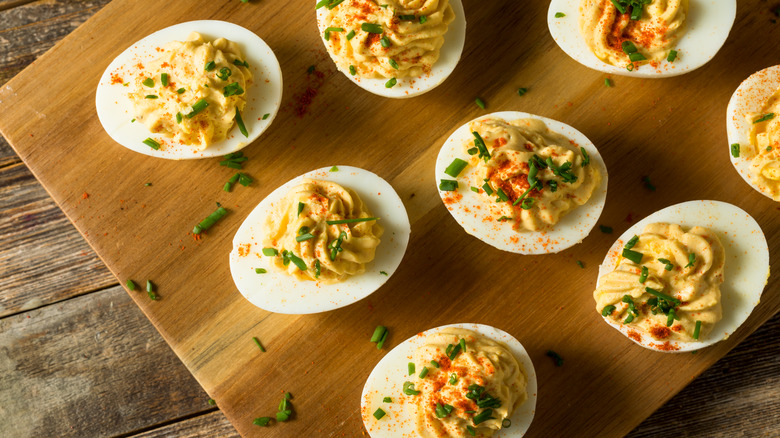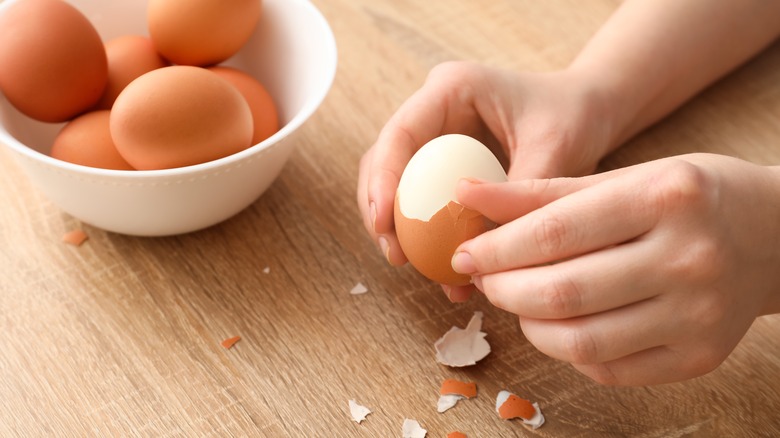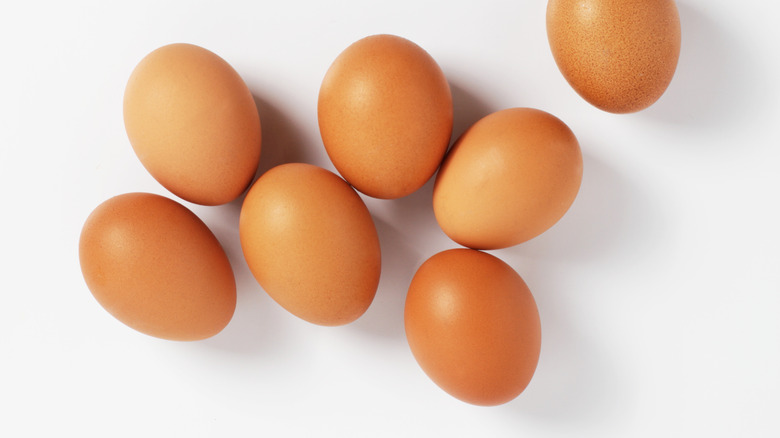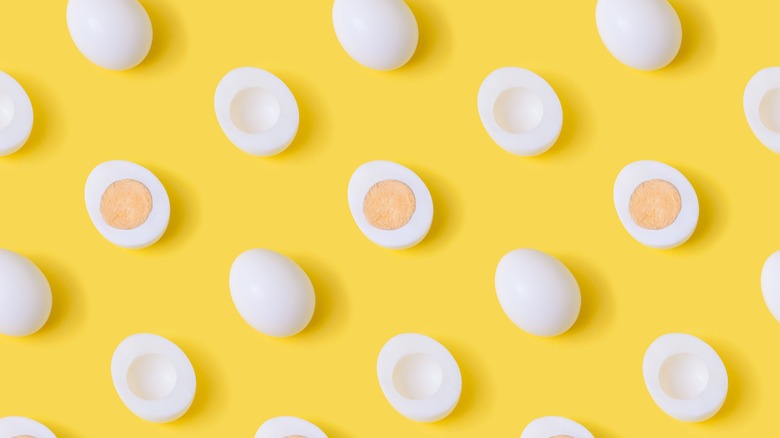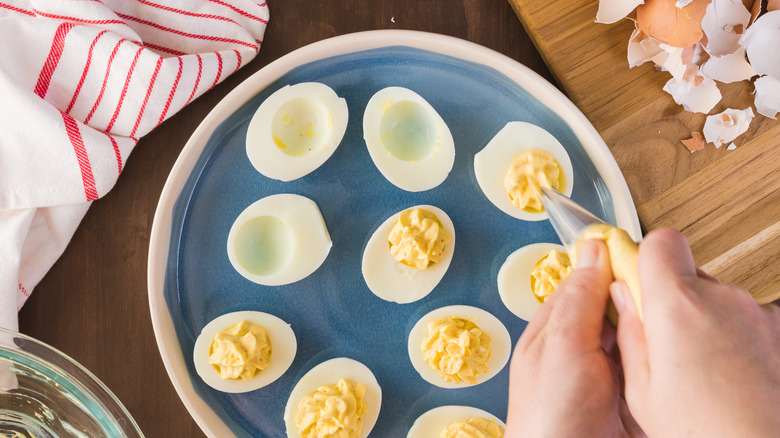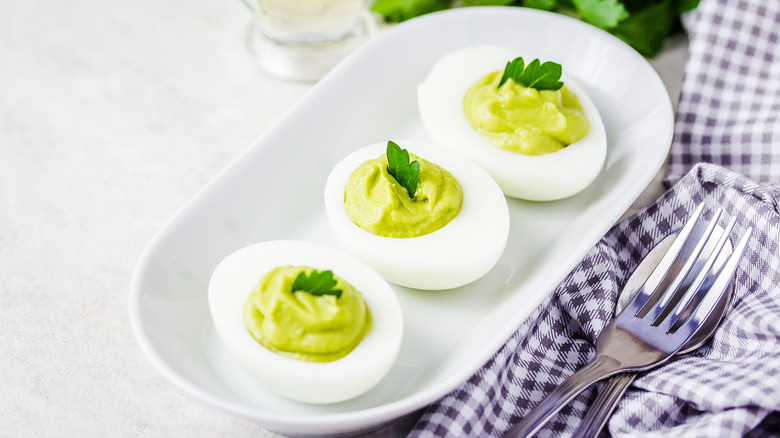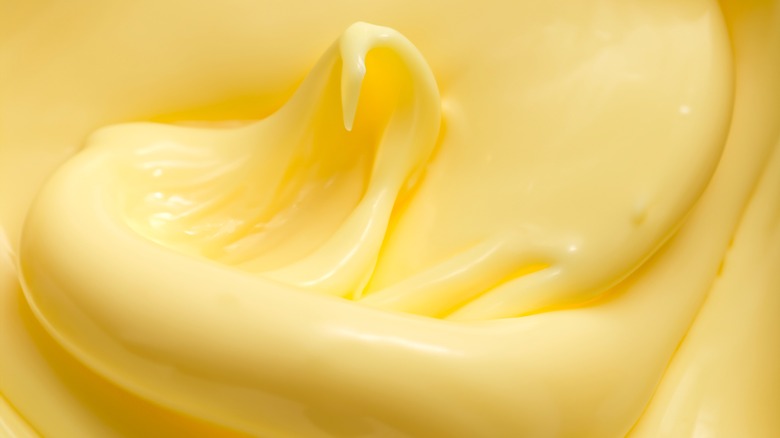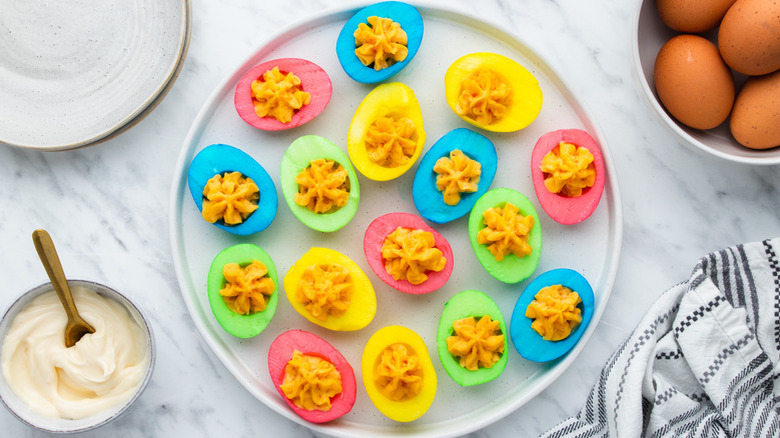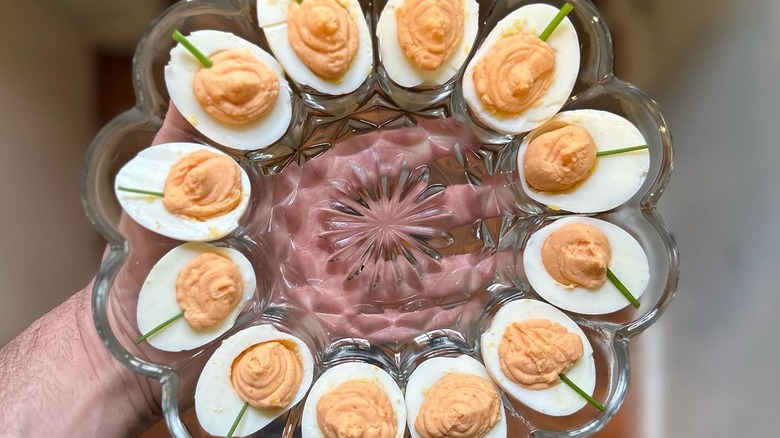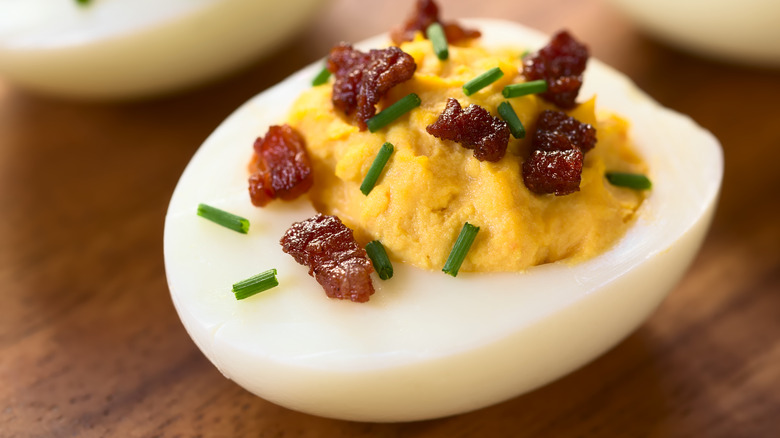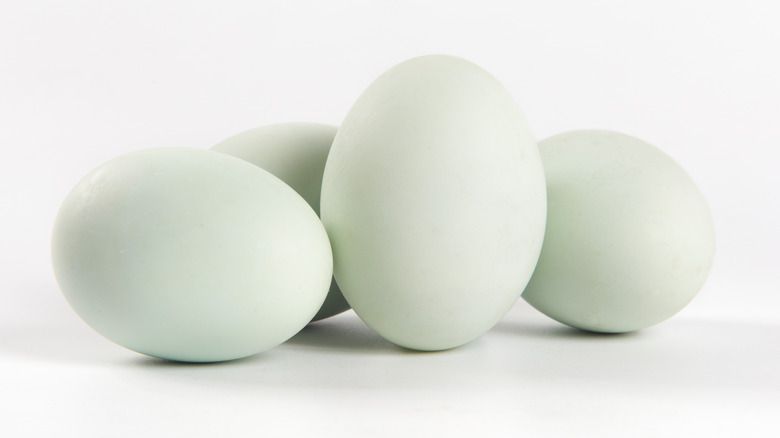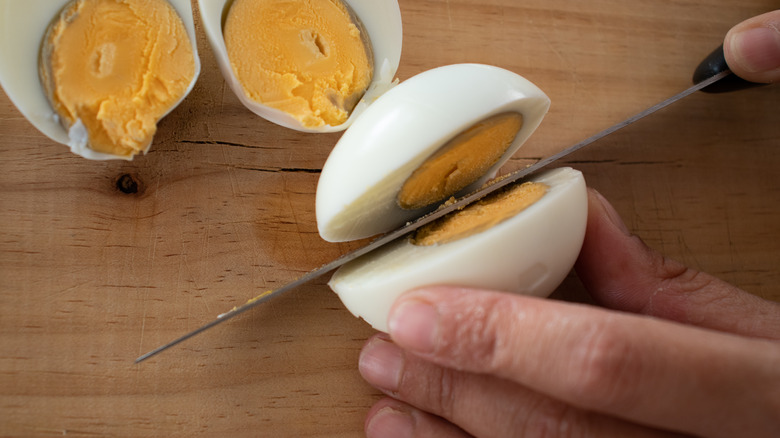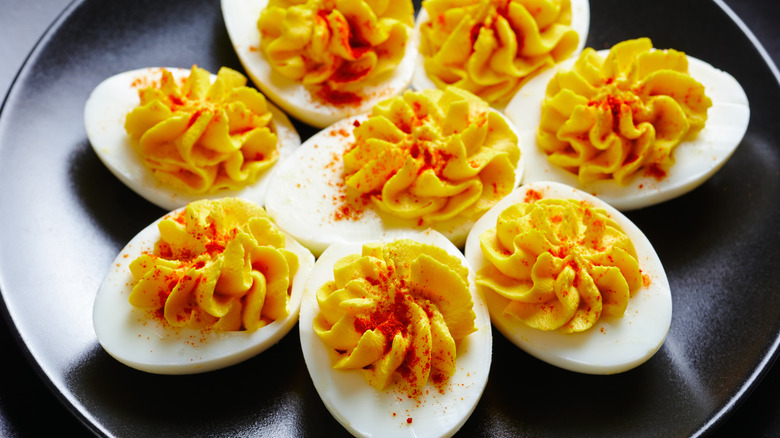Deviled Eggs Hacks You'll Wish You Knew Sooner
A timeless appetizer that never fails to please a crowd, deviled eggs are perfect for gatherings, potlucks, or even just for enjoying as a casual snack. Mastering the art of perfect deviled eggs takes some practice. But fear not, because we've gathered the ultimate collection of game-changing hacks that will revolutionize the way you approach these tasty and savory treats. From effortless prep to unique flavor enhancements, these tips will ensure you avoid those common mistakes and have you whipping up deviled eggs like a pro in no time.
Gone are the days of hard-to-peel shells, wonky yolks, and eggs sliding around on your plate. Our hacks are designed so that your deviled egg-making experience is smoother, tastier, and more enjoyable. Among these handy tips, we'll show you how to remove the yolks from the whites with ease, jazz up the filling, and add extra finesse to your deviled eggs with a simple piping bag.
So, get ready to take your deviled egg game to the next level as we explore a host of tricks that will have you wondering how you ever made deviled eggs without them.
Tap the eggs before boiling for easy peeling
Peeling hard-boiled eggs can be a frustrating task, often resulting in unsightly nicks and dents in the cooked egg white. However, this hack from a popular TikTok video shows us a simple yet effective way to achieve smooth, effortlessly peeled eggs.
Before immersing them in boiling water, give the bottom of each egg a gentle tap with a spoon. This small action creates tiny cracks in the shell, allowing for easier peeling later on. The key here is to not crack the shell too aggressively, as you don't want to damage the egg too much and have the white spilling out. A few gentle taps should suffice to create the desired effect. Once your eggs are tapped, carefully lower them into a pot of boiling water using a slotted spoon or ladle. Boil the eggs for the recommended time, typically around 12 minutes for hard-boiled eggs.
After boiling, transfer the eggs to a bowl of ice water to cool rapidly and stop the cooking process. Once they've cooled for about 10 minutes, you'll be amazed at how easily the shells slide off. The cracks created by tapping the eggs before boiling create weak points in the shell, making it a breeze to peel away in large, satisfying pieces and leaving you with a perfectly smooth egg white. You'll be left wondering why you didn't start using this trick sooner!
Store eggs sideways for perfectly centered yolks
Achieving perfectly centered yolks in your deviled eggs is a great way to make them look extra polished. One of the key factors in achieving this symmetrical outcome is how you store your eggs prior to boiling.
This handy tip comes from television cook and food writer Nigella Lawson, who claims that a simple adjustment can prevent the yolks from settling to one side of the egg. Instead of storing your eggs upright in the carton, take them out and lay them on their sides in a dish. This is because when eggs are stored upright, the yolks tend to move toward one end due to gravity. But by laying them horizontally, you encourage the yolks to remain centered within the egg, resulting in a more uniform appearance when sliced and filled. If you'd prefer to keep the eggs in their carton, try securing the lid shut with two rubber bands, then standing the carton on its side in the fridge.
Make sure to take your eggs out of the fridge and allow them to come to room temperature for about 10-15 minutes before boiling. This helps prevent cracking when they're added to the boiling water.
Try this simple knife technique to remove the yolks
Once your hard-boiled eggs are cooked to perfection and peeled, the next step in preparing deviled eggs is removing the yolks from the whites. While this may seem straightforward, using a simple knife technique can make the process even easier and yield cleaner results.
In her viral TikTok video, Andrea VanDerwerker demonstrates a seemingly effortless separation of yolk and white. She doesn't attempt to scoop out the yolks with a spoon, which can sometimes lead to uneven edges or accidental breakage of the egg whites. Instead, she uses a knife and a simple rolling action. First, place your peeled, whole, hard-boiled egg on a chopping board. Then, take a sharp knife and place the edge closest to the handle on the egg as if about to cut lengthways down the middle. As you start to cut into the egg, rather than slicing straight down, draw the knife toward you while keeping it parallel to the board and maintaining a constant distance from the board. The egg should roll toward you as you slice through the white — but not the yolk. Once the egg rolls all the way around, the white splits in half, with the yolk cleanly popping out.
As you remove each yolk, transfer it to a separate bowl where you'll mix it with the desired ingredients to create the deviled egg filling. Repeat this process for all of the eggs until you've successfully removed all of the yolks.
Use a piping bag for extra finesse
Creating a beautifully piped filling for each deviled egg adds a touch of elegance to your presentation and allows for precise portioning of the filling. While spooning the filling into the egg whites can be a quick and simple option, using a piping bag takes your deviled eggs to the next level.
For this technique, you'll need a piping bag fitted with a decorative tip of your choice. A closed star tip should work well here to give you that classic swirl for a polished finish, but you can experiment with different tips to achieve various textures and shapes. If you don't have a piping bag on hand, you can easily make one by filling a plastic storage bag with the prepared filling and snipping off a small corner.
Once your piping bag is ready, spoon the prepared deviled egg filling into the bag, avoiding overfilling to prevent messiness. Twist the top of the bag to secure the filling inside, then gently squeeze the bag to push the filling toward the tip. Position the tip of the piping bag over one of the egg white halves, applying gentle pressure to release the filling as you move the bag in a swirling motion. Continue piping until the egg white is generously filled with the desired amount of filling, then repeat the process with the remaining egg halves.
Switch up the mayo for a lighter option
Traditionally, deviled egg fillings are made with mayonnaise, which adds richness and creaminess to the dish. However, if you're looking to lighten up your deviled eggs or explore new flavors, try swapping out the mayo for a lighter alternative.
Greek yogurt is an excellent substitute for mayo in the deviled egg filling, offering a tangy flavor and creamy texture with a lower fat content. Simply replace the mayo called for in your favorite deviled egg recipe with an equal amount of Greek yogurt, adjusting the seasoning to your taste. Alternatively, avocado can also be used as a creamy and nutritious replacement for mayonnaise. Mash ripe avocado and mix it with the egg yolks for a filling that's rich in flavor and packed with healthy fats. You can also blend the avocado with Greek yogurt for a doubly light and creamy filling. For a dairy-free option, try using hummus as the base for your deviled egg filling. Hummus adds a subtle nutty flavor to the filling while maintaining a creamy consistency, making it a delicious alternative to work with.
Whichever option you choose, don't forget to season the filling with salt, pepper, and any other desired herbs or spices to enhance the flavor. You can also add a splash of lemon juice or vinegar for a subtle tanginess that balances out the richness of the filling.
Add butter to the filling
An easy way to enhance the richness and flavor of your deviled eggs is by incorporating a surprising ingredient into the filling. While mayonnaise is usually the primary fat component here, adding butter can introduce a luxurious creaminess and depth of flavor to make your eggs extra special.
To integrate butter into your deviled egg filling, start by ensuring the butter is at room temperature for easy mixing. Combine softened butter with the mashed egg yolks and mayo, along with any other desired ingredients such as mustard, vinegar, or spices. As you blend the butter into the filling, you'll notice that the texture becomes velvety smooth. Once piped into the egg whites, your finished deviled eggs will look and taste super decadent.
Be mindful not to overpower the filling with too much butter, as a little goes a long way in adding richness. A couple of tablespoons of butter with yolks from a dozen eggs is a generally a good place to start.
Get creative with food colorings
If you're looking to inject some fun into your deviled eggs, get creative with food colorings to add a burst of vibrant color to the egg whites. It's a great way to transform them into the ultimate eye-catching appetizer, like in our Easter deviled eggs recipe.
Start by selecting your desired colors. Good quality, store-bought gel food colorings are ideal for achieving intense, concentrated hues, though there are also some effective natural substitutes for coloring to try. From springtime pastels to jewel-toned shades for festive occasions, there are plenty of shades to choose from to give your eggs a stunning new look.
Once you've boiled, peeled, and removed the yolks from your eggs, it's time to dye the whites. Grab a bowl for each color you're using, and fill it with about two cups of water. Then, add a few drops of each food coloring to each bowl, and stir until it's nice and vibrant. Carefully place the halved egg whites into the colored water bowls, and ensure they are fully submerged. Let them soak for about five minutes, allowing the colors to infuse. Once they've taken on their beautiful new hues, remove the egg whites from the dye one at a time and gently dab them dry with paper towels. With the vibrant, colored egg whites ready, it's time to fill them with the prepared deviled egg mixture and showcase those colorful exteriors.
Level off the bottoms or use an egg platter for fuss-free serving
Have you ever carefully arranged your deviled eggs on a plate, only to find that they slide around everywhere as soon as you pick up the dish? Thankfully, there are some simple hacks you can use to ensure perfect presentation every time.
The first method involves leveling off the bottoms of the egg whites. After halving the eggs and removing the yolks, place each egg white half, cut side down, on a cutting board. Using a sharp knife, carefully trim a small slice from the rounded bottom of each egg white, creating a flat surface. This will allow the eggs to sit securely on your serving platter without wobbling or sliding around.
Alternatively, for fuss-free serving, you could invest in an egg platter specifically designed for deviled eggs. These specialized serving trays feature molded wells to hold each egg half, keeping them perfectly snug and secure. These platters come in all different shapes and sizes, with some even featuring a larger section in the middle to fill with dips, crudités, or other appetizers that complement the eggs.
Add a little crunch
To complement that delicious, creamy egg yolk filling, adding some extra ingredients to your deviled eggs that bring a little crunch can be a great way to elevate them. There are plenty of options to choose from, and you can either mix them through the filling or simply place them on top of the finished eggs as a garnish.
One simple and popular way to introduce crunchiness to your deviled eggs is adding some cooked bacon bits. With their crisp texture and smoky flavor, they're the perfect savory pairing for those creamy yolks. Stir them through the yolk mixture, or simply scatter them on top.
Another great way to add some crunch is garnishing the eggs with fresh diced veggies, such as radish, celery, or red bell pepper. Or, for a spicy kick, go for some sliced jalapeño peppers. As well as bringing that satisfying contrast of textures to every bite, using colorful veggies will make your eggs look great too! Be sure to finely chop the veg to ensure it can perch nicely on top of the eggs and blend seamlessly with the filling as you bite into it.
Try using duck eggs
For a unique twist on the classic, why not try using duck eggs in your recipe? Duck eggs offer a richer flavor and more luxurious texture compared with chicken eggs, so they make for a fantastic option if you want to add a touch of sophistication to your deviled eggs.
One key difference between chicken and duck eggs is their size, with the latter typically being larger. When hard-boiled, their yolks also possess different textures. According to Hoffman's Little Acres, duck egg yolks will maintain a smooth, creamy texture, even when fully cooked through. Chicken eggs, on the hand, can feature drier, crumblier yolks.
When using duck eggs in deviled eggs, follow the same basic method as you would with chicken eggs. Begin by boiling, peeling, and slicing the duck eggs. Then, mash the yolks up with your add-ins of choice to get that lovely velvety filling, before returning it to the hollowed egg whites.
Wipe your knife between slices
When it comes to slicing the boiled eggs in half, it can be tricky to avoid getting bits of notoriously sticky yolk on the knife, even if you've opted for the easy TikTok rolling method. A simple wipe of the knife between slicing each egg will help you achieve clean, precise cuts, and you won't have to waste any time wiping bits of yolk from the egg whites later on.
Select a sharp, thin-bladed, non-serrated knife for slicing the eggs. This will help you slice them swiftly without squashing or distorting the egg whites. After each slice, use a clean, damp cloth or paper towel to wipe the blade of the knife, removing any yolky residue that might otherwise get transferred onto subsequent slices.
It's a simple but effective step that will ensure neat and professional-looking deviled eggs, helping you achieve impressive presentation that's sure to wow your guests.
Strain, don't mash
When preparing the filling for your deviled eggs, getting that smooth and creamy texture is key to a delicious end result. While simply mashing the egg yolks with a fork can be a quick and effective method, another way to achieve an extra velvety consistency is passing the cooked egg yolks through a strainer.
To strain the egg yolks, start by transferring them to a fine-mesh strainer that's placed over a bowl. Using the back of a spoon or a rubber spatula, press the yolks firmly through the strainer, scraping and working them until they pass through completely. This process removes any lumps or chunks and results in a silky-smooth filling that melts in your mouth. Once the egg yolks are strained, mix them with the other filling ingredients until well combined, and spoon or pipe everything into the prepared egg white halves.
This refined approach to preparing the filling will certainly set your deviled eggs apart, with your attention to detail resulting in an ultra smooth, creamy texture that's sure to impress your guests.
